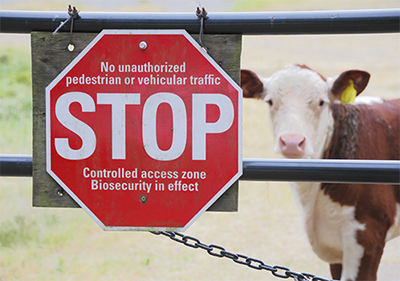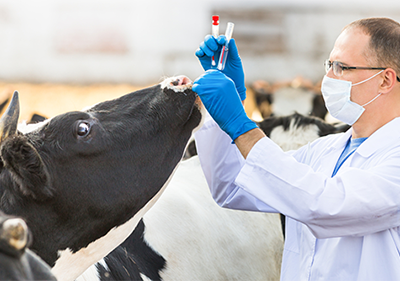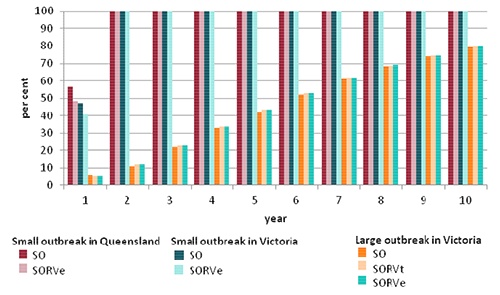Authors: Benjamin Buetre, Santhi Wicks, Heleen Kruger, Niki Millist, Alasebu Yainshet, Graeme Garner, Alixaandrea Duncan, Ali Abdalla, Charlene Trestrail, Marco Hatt, Lyndal-Joy Thompson and Michael Symes


In this report, Potential socio-economic impacts of an outbreak of foot-and-mouth disease in Australia, ABARES assesses the economic costs and social impacts of a hypothetical outbreak of foot‑and‑mouth disease (FMD) in Australia. FMD is a highly contagious viral infection of cloven hoofed mammals, including cattle, sheep, goats, pigs, deer and camels. Overseas experience shows the disease has serious economic and social implications, particularly for countries producing and exporting livestock and livestock products.
When countries have an outbreak of FMD their livestock export products become subject to trade bans designed to reduce the risk of transmitting the disease to livestock in other countries. For large exporters like Australia, this would most likely result in affected meat products being diverted to the domestic market (as the meat is safe for human consumption) with a consequent reduction in product prices and financial returns to producers. An outbreak can also lead to significant social disruption in the surrounding communities.
Three outbreak scenarios were used to estimate the economic impacts of FMD:
- a small outbreak in North Queensland, where most cattle are raised on extensive rangelands
- a small outbreak in Victoria’s Goulburn Valley, which has a high density of livestock and intensive dairy farms
- a large multi-state outbreak that, by the time FMD is detected, has spread from Victoria to all eastern states (New South Wales, Queensland, South Australia, Victoria and Tasmania).
The disease control strategies examined included the destruction and disposal of animals (stamping out) with and without extensive or targeted vaccinations.
In the event of a large multi-state FMD outbreak, estimated revenue losses of between $49.3 billion and $51.8 billion (in present value terms) were expected over 10 years (Table 1). These revenue losses accounted for around 99 per cent of direct economic costs, with the remaining 1 per cent being the cost of disease control. The cost of control increases with the size of an outbreak because more animals must be managed. Control costs were estimated at between $60 million and $373 million, with $6.3 million to $60.2 million representing compensation to farmers for animals destroyed during control procedures.
For the simulated examples of two small FMD outbreaks in Queensland and Victoria, assuming that export markets lift bans on Australian meat products quickly (Figure 2), estimated revenue losses of between $5.6 billion and $6.2 billion (in present value terms) over 10 years were expected, depending on the response strategy used (Table 1).
Other industries may be positively or negatively affected by the outbreak, depending on their relationship with livestock industries. Selected input providers to FMD-susceptible livestock production (for example, transport, trade and feedstock suppliers) could see reductions in the present value of production of $11.5 billion over 10 years. However, other industries such as grain and horticulture and their downstream processors may benefit, with an estimated increase in the present value of production of $15 billion over 10 years, compared with no FMD outbreak. These increases are the result of resources, such as land, being diverted from livestock to other agricultural uses.
| Scenario/strategy | Control costs ($b) |
Revenue losses ($b) |
Total direct cost ($b) |
|---|---|---|---|
| Small outbreak in North Queensland | |||
| Stamping out a | 0.06 | 5.58 | 5.64 |
| Stamping out with extensive vaccination | 0.06 | 5.90 | 5.96 |
| Small outbreak in Victoria | |||
| Stamping out | 0.10 | 5.90 | 6.00 |
| Stamping out with extensive vaccination | 0.09 | 6.17 | 6.26 |
| Large multi-state outbreak | |||
| Stamping out | 0.37 | 51.84 | 52.21 |
| Stamping out with extensive vaccination | 0.35 | 49.54 | 49.89 |
| Stamping out with targeted vaccination | 0.32 | 49.29 | 49.62 |
a Stamping out refers to the destruction and disposal of animals
Note: Present value of costs (2011–12 dollars) calculated at a discount rate of 7 per cent
Figure 2 Annual beef exports for different FMD outbreak scenarios and eradication strategies. The model assumes that export bans are lifted quickly after small outbreaks

Overall, the modelling results estimated that a large multi-state FMD outbreak would reduce Australia’s gross domestic product (GDP) by 0.16 per cent or $23.6 billion in present value terms over 10 years, while the small Victorian outbreak would result in a reduction of 0.03 per cent or $4.6 billion.
In the event of an FMD outbreak, social impacts may occur at the individual, household and community levels. Many social impacts are generated by the loss of income, such as mental health issues and reduced welfare. Other impacts may result from the control measures used to manage and eradicate FMD. The severity of these impacts will be influenced not only by the size of the outbreak and time out of export markets, but also the vulnerability of a community and its ability to recover. Communities with good economic performance and socio-advantage are likely to be more resilient and recover more quickly from an FMD outbreak.
Download the full report
Potential socio-economic impacts of an outbreak of foot-and-mouth disease in Australia - PDF
Potential socio-economic impacts of an outbreak of foot-and-mouth disease in Australia - DOCX
